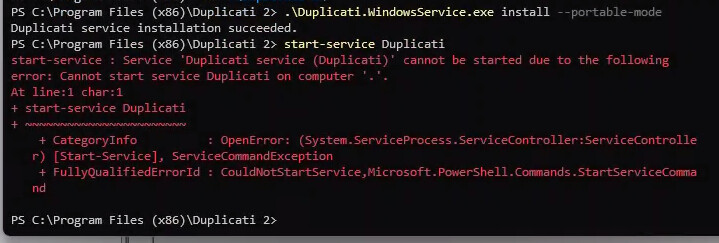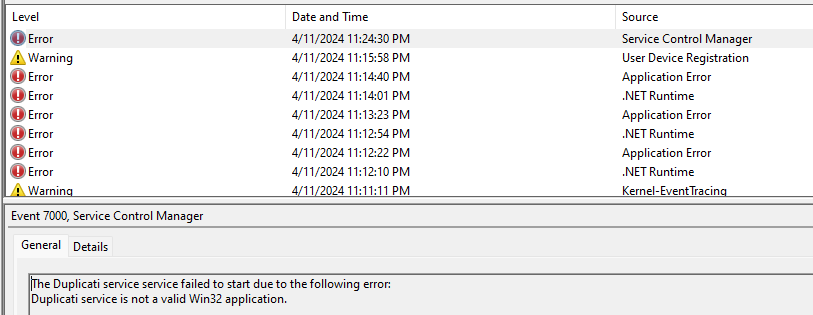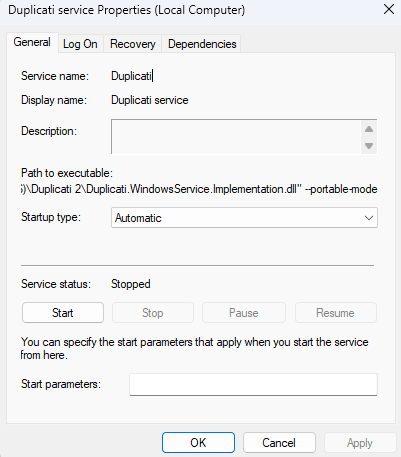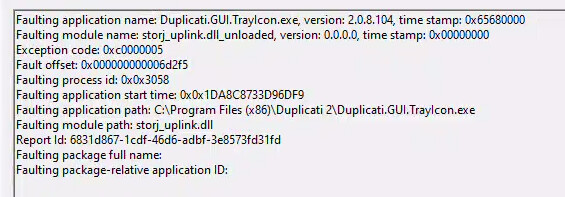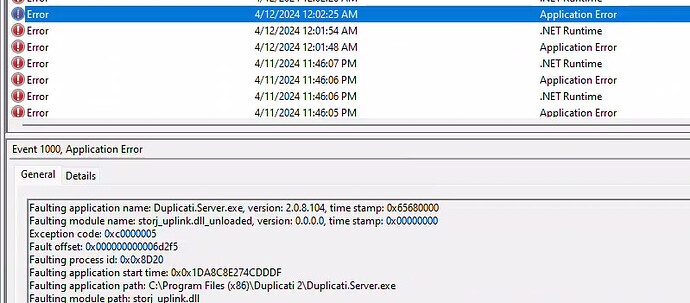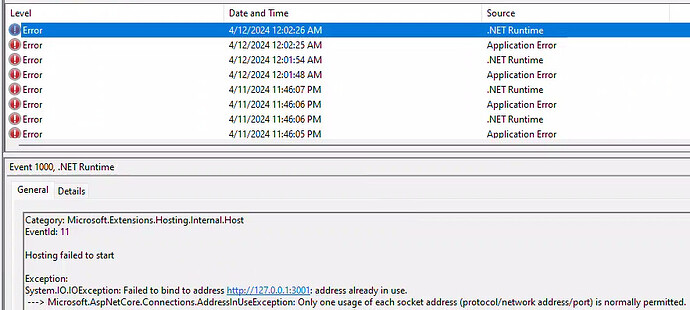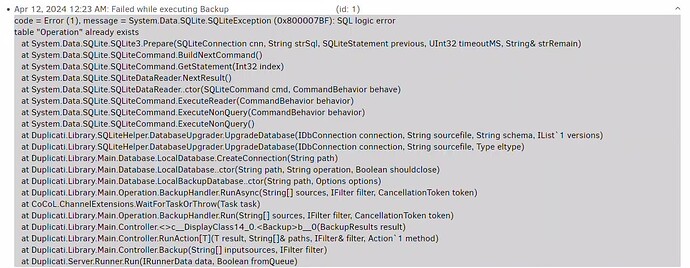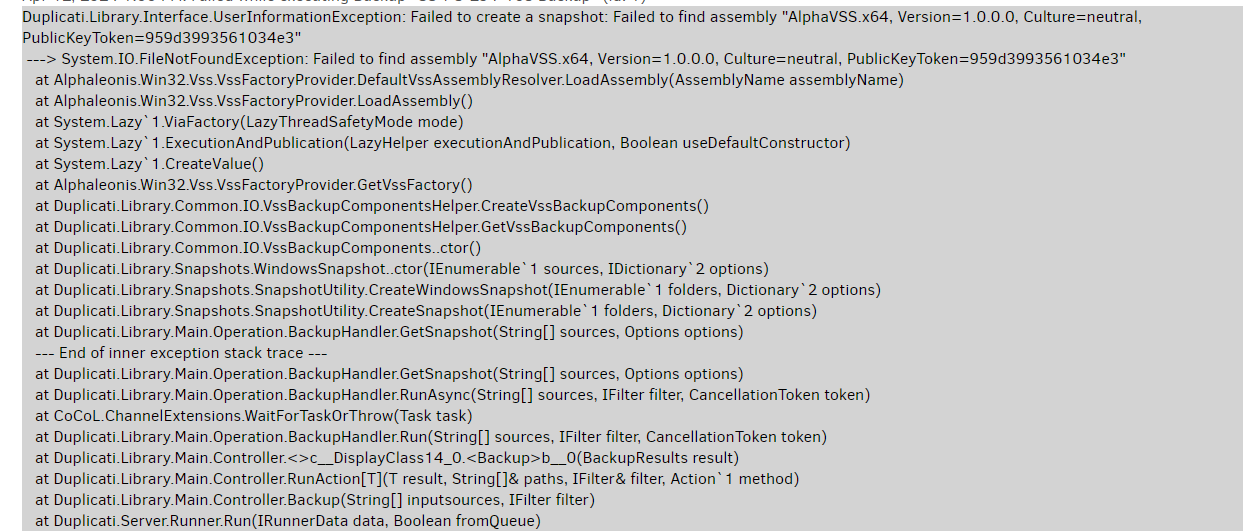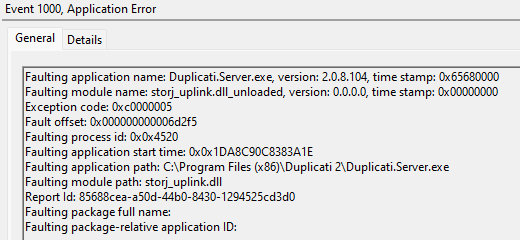I didn’t see anything like the old one. I minimized all windows while looking. It’s possible I still missed it.
This makes for the previous awkward stop where I Control-C, and have to do it twice to actually stop it.
There is also the “automatic index” warning, but there are fewer. I didn’t bother looking up history on that.
It seems to run a lot like the normal one.
Yes, but tilde moves. The systemd one is root, not me. The rest of your path looks different, BTW. It was ~/.config/Duplicati, and I assumed it still was, since I saw some old jobs. I hope it didn’t really move.
Speaking of moves, I tried Windows 10 with the .msi install x64 version this time, and watched it delete C:\Program Files\Duplicati 2 (good thing I didn’t use portable mode) and install below Program Files (x86)…
I figured I’d try it. Task Manager shows it up for about 1 second, and Application event log caught its death.
EDIT:
Sysinternals sigcheck says that TrayIcon in (x86) is 64 bit, so maybe the confusion is in the .msi installer.
SQLiteDecryptTool does not run after I unzip it to folder, although this error message sounds a bit familiar:
C:\Users\Maintenance\Downloads\SQLiteDecryptTool\SQLiteDecryptTool>sqlitedecrypttool.exe
Duplicati Database Decryption Tool
Duplicati version 2.0 used a weak RC4 encryption algorithm to encrypt the database.
The RC4 and other methods are no longer supported for SQLite with the native libraries
The encryption support was primarily available on Windows, but could have been available on other platforms.
This tool will decrypt the database and save a backup before attempting to decrypt it.
Found database in default location: C:\Users\Maintenance\AppData\Local\Duplicati\Duplicati-server.sqlite
Do you want to decrypt this database? (y/n): y
Creating a copy of the database in C:\Users\Maintenance\AppData\Local\Duplicati\Duplicati-server_backup_enc.sqlite...
Decrypting the database...
Unhandled Exception: System.NotSupportedException: An attempt was made to load an assembly from a network location which would have caused the assembly to be sandboxed in previous versions of the .NET Framework. This release of the .NET Framework does not enable CAS policy by default, so this load may be dangerous. If this load is not intended to sandbox the assembly, please enable the loadFromRemoteSources switch. See http://go.microsoft.com/fwlink/?LinkId=155569 for more information.
at System.Reflection.RuntimeAssembly.nLoadFile(String path, Evidence evidence)
at System.Reflection.Assembly.LoadFile(String path)
at Duplicati.Library.SQLiteHelper.SQLiteLoader.get_SQLiteConnectionType()
at Duplicati.Library.SQLiteHelper.SQLiteLoader.LoadConnection()
at SQLiteDecryptTool.Program.Main(String[] args)
On .zip file, try right click → Properties and check the Unblock box: Finish, extract, try running it again.

Seeming success:
C:\Users\Maintenance\Downloads\SQLiteDecryptTool\SQLiteDecryptTool>sqlitedecrypttool.exe
Duplicati Database Decryption Tool
Duplicati version 2.0 used a weak RC4 encryption algorithm to encrypt the database.
The RC4 and other methods are no longer supported for SQLite with the native libraries
The encryption support was primarily available on Windows, but could have been available on other platforms.
This tool will decrypt the database and save a backup before attempting to decrypt it.
Found database in default location: C:\Users\Maintenance\AppData\Local\Duplicati\Duplicati-server.sqlite
Do you want to decrypt this database? (y/n): y
Creating a copy of the database in C:\Users\Maintenance\AppData\Local\Duplicati\Duplicati-server_backup_enc.sqlite...
Decrypting the database...
Database decrypted successfully!
Press enter to close the program
The symptom before the decrypt was:
C:\Program Files (x86)\Duplicati 2>Duplicati.Server.exe
Unhandled exception. System.Exception: A serious error occurred in Duplicati: System.Exception: Failed to create, open or upgrade the database.
Error message: file is not a database
file is not a database
at Duplicati.Server.Program.GetDatabaseConnection(Dictionary`2 commandlineOptions)
at Duplicati.Server.Program.Main(String[] _args)
---> System.Exception: Failed to create, open or upgrade the database.
Error message: file is not a database
file is not a database
at Duplicati.Server.Program.GetDatabaseConnection(Dictionary`2 commandlineOptions)
at Duplicati.Server.Program.Main(String[] _args)
--- End of inner exception stack trace ---
at Duplicati.Server.Program.Main(String[] _args)
at Duplicati.Server.Net8.Program.Main(String[] args)
After decrypt, Duplicati.Server.exe is available (unlike TrayIcon crash) if I browse to it manually. Good.
Spoke too soon. I saw the web UI for a few seconds (complete with an invitation to update to 2.0.6.3).
It lost the connection after that, and the event log shows the crash again. Terminal returned to prompt.
Event 1000, Application Error:
Faulting application name: Duplicati.Server.exe, version: 2.0.8.104, time stamp: 0x65680000
Faulting module name: ntdll.dll, version: 10.0.19041.4239, time stamp: 0xad5435e9
Exception code: 0xc0000409
Fault offset: 0x00000000000a2350
Faulting process id: 0x7d8
Faulting application start time: 0x01da8c47e49ad031
Faulting application path: C:\Program Files (x86)\Duplicati 2\Duplicati.Server.exe
Faulting module path: C:\WINDOWS\SYSTEM32\ntdll.dll
Report Id: c41364bd-f035-4824-8c10-6c2c81e39175
Faulting package full name:
Faulting package-relative application ID:
Event 1001, Windows Error Reporting:
Fault bucket 1741720627435224920, type 5
Event Name: BEX64
Response: Not available
Cab Id: 0
Problem signature:
P1: Duplicati.Server.exe
P2: 2.0.8.104
P3: 65680000
P4: ntdll.dll
P5: 10.0.19041.4239
P6: ad5435e9
P7: 00000000000a2350
P8: c0000409
P9: 000000000000000a
P10:
Attached files:
\\?\C:\ProgramData\Microsoft\Windows\WER\Temp\WER1E29.tmp.mdmp
\\?\C:\ProgramData\Microsoft\Windows\WER\Temp\WER4029.tmp.WERInternalMetadata.xml
\\?\C:\ProgramData\Microsoft\Windows\WER\Temp\WER4098.tmp.xml
\\?\C:\ProgramData\Microsoft\Windows\WER\Temp\WER40D4.tmp.csv
\\?\C:\ProgramData\Microsoft\Windows\WER\Temp\WER4171.tmp.txt
These files may be available here:
\\?\C:\ProgramData\Microsoft\Windows\WER\ReportArchive\AppCrash_Duplicati.Server_392f54b13ca6e7113b7c7fe172189a463a5057_b4d0357b_bf53bffe-27b4-4a49-bb37-4d05e7b842d5
Analysis symbol:
Rechecking for solution: 0
Report Id: c41364bd-f035-4824-8c10-6c2c81e39175
Report Status: 268435456
Hashed bucket: fb5de0f97a4c6e79982bd5aec03f3f58
Cab Guid: 0
Trying to use F12 Developer Tools in Edge to look at the network, I “think” the first non-response was to
http://localhost:8200/api/v1/serverstate/?lasteventid=-1&longpoll=false&duration=299s
The old web server didn’t have any easy way to log incoming traffic. Does the new one do better there?
Having a hard time getting any CommandLine programs to run on Windows. BackendTester can report Starting run no 0 before silence. BackendTool can give its help, which is more than CommandLine. Application event log is full of the crashes.



